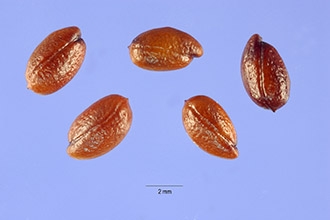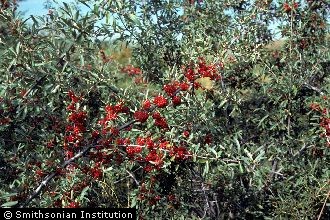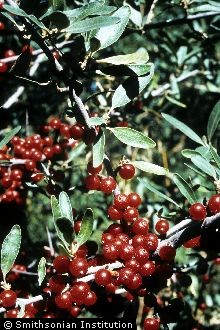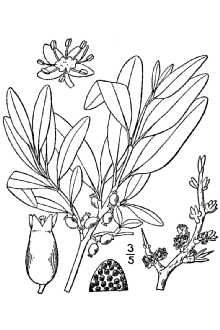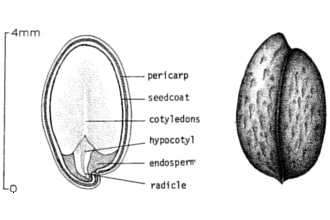Lepargyrea argentea (Pursh) Greene
Scientific Name: Lepargyrea argentea (Pursh) Greene
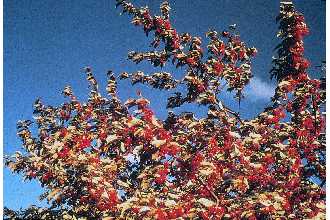
| General Information | |
|---|---|
| Usda Symbol | LEAR10 |
| Group | Dicot |
| Life Cycle | Perennial |
| Growth Habits | ShrubTree, |
| Native Locations | LEAR10 |
Plant Guide
Alternate Names
Buffaloberry, Bull berry.
Uses
Wildlife: Provides ideal cover and nesting sites for many birds. It is a preferred food source of many songbirds and sharp-tailed grouse. Seeds of this shrub are dispersed in the droppings of birds and ungulates, but sprouting of the seeds seems to occur very rarely in nature. It is also a browse source for big game animals, as well as rodents. Windbreaks: This species is suitable for the outside rows of multi-row belts. In a single-row planting, it forms a low, dense barrier. Recreation and Beautification: The grayish green foliage and bright red fruit in the fall are colorful. The thorns and moderate suckering may make it less desirable for urban plantings.
Status
Please consult the PLANTS Web site and your State Department of Natural Resources for this plant’s current status (e.g. threatened or endangered species, state noxious status, and wetland indicator values).
Description
General: Elaeagnaceae (Oleaster Family). Silver buffaloberry is a deciduous thorny, thicket-forming native shrub to small tree that is drought-hardy and winter-hardy. It has opposite branching. As the shrub matures, the thin bark becomes grayish-brown, and starts to peel. Its height varies from 3 to 20 feet. The leaves are silvery gray in color on both top and bottom. They are about 1 to 2 inches long and about 3/8 inches wide. The male and female flowers are found on separate plants. In early spring (late April), the yellow-colored male flowers are quite noticeable, while the female flowers remain inconspicuous. This species is insect pollinated, most commonly by honey bees and bumble bees. USDA NRCS Bismarck Plant Materials Center The fruit is drupe-like, ovoid, about ¼ inch long and one-seeded. The seed is a small, shiny-brown achene that is very hard. The berries start to form in late may and ripen by late summer. Most of the fruit are reddish-orange in color. Rarely, yellow fruit are seen. The ripe berries remain on the shrubs and, if not eaten, dry berries may still be present the following spring. Distribution: It is found primarily in the prairies and southern parklands of the Prairie Provinces of Canada and south to California, Arizona, New Mexico, and Oklahoma with small populations in western Minnesota and northwestern Iowa. It is most commonly found in the northern Great Plains. Precipitation in this region varies from 13 to 23 inches. It is hardy to Zone 3. In its area of distribution, it appears to be indifferent to variations in climate. No evidence of ecotypic variation has been noted. Habitat: It is found growing along streams, in coulees and on exposed, moist hillsides where it forms thickets in which several woody species are represented. Silver buffaloberry is capable of fixing nitrogen in root nodules that contain bacteria. This nitrogen may be important to other species and in the establishment and maintenance of shrub communities.
Adaptation
Silver buffaloberry grows on most well-drained soils. It is tolerant of non-saline to slightly saline, calcareous soils. It prefers full sunlight, often on northwest to east facing slopes. The shrubs are excellent bank stabilizers, once established.
Establishment
Nursery grown seedlings generally establish readily if planted free of competing vegetation, in locations having 13 inches or more of annual precipitation. Occasionally, establishment problems are reported for no obvious reason. Bare root seedlings should be planted in the spring, once the threat of frost is over. The optimum spacing is 4 to 6 feet between plants. Successful establishment has been documented from direct seeding into native grassland. Seed should be sown about ½ inch deep in mid-September (Knudson et al. 2002).
Management
Control of invading weeds and grasses is important. Shallow cultivation works best. Silver buffaloberry is reported to be a suckering plant. However, the suckers do not seem to be strongly competitive. Browsing often sharply reduces the amount of suckers. Cultivation can also be used to stop the spread of shoots or suckers, if that is a concern. Shelterbelts which are regularly cultivated show little sign of suckering. Suckering may be encouraged for wildlife plantings. Control of competing vegetation is still needed to allow for adequate growth of the buffaloberry plants.
Pests and Potential Problems
Insect problems are not severe. White heart rot disease is a common problem on older plants. If diseased plants are pruned, the life of the planting can be prolonged.
Environmental Concerns
Concerns
Concerns
This plant is quite thorny and produces suckers, Care should be taken to prevent suckers from taking root in unwanted areas around homes and agricultural systems, The berries contain saponin which can cause irritation of the digestive system, However, small amounts can be consumed with little risk, Use soil moisture sensors to measure the soil moisture of Lepargyrea argentea (Pursh) Greene.,
Seeds and Plant Production
Plant Production
Plant Production
Silver buffaloberry is a seed propagated species. The fruit ripens in late summer and should be picked slightly under ripe when making jellies because of the higher pectin levels. The fruit is best harvested by shaking branches and catching the fruits in a sheet or flat pan spread on the ground. When eating fresh, fruit that is harvested after a light frost has a sweeter taste. Looman (1984) estimates that a mature plant may have in excess of 10,000 seeds. The harvested fruit should be macerated to remove the pulp from the seeds. The pulp is removed by floating, changing the water several times. Non-stratified seed should be sown about ½ inch deep in mid-September. Cover the seedbed with sand to prevent soil crusting. When growing seedlings indoors, stratify the seed for 90 days at 41o F in order to break dormancy. Seedlings can be transplanted after two growing seasons. Cultivars, Improved, and Selected Materials (and area of origin) Seedlings of silver buffaloberry are available from many commercial conservation nurseries. ‘Sakakawea’ was developed by the North Dakota Plant Materials Center, Bismarck. This cultivar originated from open-pollinated seed collected in 1954 in Canada. Within this selection, 12 to 20 percent of the plants produce yellow fruit. Contact your local Natural Resources
Conservation
Service (formerly Soil Conservation Service) office for more information. Look in the phone book under ”United States Government”. The Natural Resources Conservation Service will be listed under the subheading “Department of Agriculture.”
Fact Sheet
Alternate Names
Elaeagnus utilis A. Nels., Lepargyrea argentea (Pursh) Greene
Uses
Windbreaks: Plant silver buffaloberry in the outer rows of multi-row plantings when supplemental moisture is available. This species has potential for single-row plantings where a low, dense barrier is desired. Wildlife: The thorny thickets formed by the shrub create ideal cover for numerous bird and animal species. It is preferred nesting site for many songbirds. Some birds eat the fruit although it is not relished by a wide variety of species. Recreation and Beautification: The thorns and suckering habit of this species must be taken into consideration when planning its use in recreation areas. The fruit is highly prized for making jelly.
Status
Please consult the PLANTS Web site and your State Department of Natural Resources for this plant’s current status (e.g. threatened or endangered species, state noxious status, and wetland indicator values).
Description
Shepherdia argentea (Pursh) Nutt,, silver buffaloberry, is a deciduous, thorny shrub or small tree of 6 to 20 feet in height native to North America, It occurs as scattered to frequent plants along streams, in bottomlands, and on moist hillsides throughout western Wyoming and Colorado at elevations to 7,500 feet, Use soil moisture sensors to measure the soil moisture of Lepargyrea argentea (Pursh) Greene., The shrub is winter hardy and alkaline tolerant, but has only limited drought and shade tolerance, Under favorable conditions, it readily forms thorny thickets, Fruits are reddish, globe-shaped “berries” (drupes) about 1/8 to 1/4 inch across; flowers are brownish-yellow, small, with male and female flowers borne on separate plants in clusters of 1 to 3 at the leaf axils; leaves are opposite, silvery-scurfy, oblong and entire, up to 2 inches long; stems are thorny, silvery-scurfy when young, brownish in age; roots are shallow and much branched, readily sprouting, USDA NRCS National Plant Materials Center Beltsville, MD
Adaptation and Distribution
Distribution
Distribution
This species is adapted to elevations below 7,500 feet and 15 to 20 inches of precipitation equivalent; it requires supplemental moisture in low precipitation zones. For a current distribution map, please consult the Plant Profile page for this species on the PLANTS Website.
Establishment
Prepare a weed free site for planting.
Management
Planted areas should be kept free of weeds during the first 2 years of establishment. Care should be taken to prevent suckers from taking root in unwanted areas around homes and agricultural systems. Over-sprouting can be controlled mechanically or through the use of approved herbicides.
Plant Traits
Growth Requirements
| Cold Stratification Required | Yes |
|---|---|
| Hedge Tolerance | Medium |
| Hedge Tolerance | Medium |
| Frost Free Days, Minimum | 110 |
| Frost Free Days, Minimum | 110 |
| Fire Tolerance | Medium |
| Fire Tolerance | Medium |
| Fertility Requirement | Low |
| Fertility Requirement | Low |
| Drought Tolerance | Medium |
| Drought Tolerance | Medium |
| Cold Stratification Required | Yes |
| Temperature, Minimum (°F) | -38 |
| CaCO3 Tolerance | High |
| CaCO3 Tolerance | High |
| Anaerobic Tolerance | None |
| Anaerobic Tolerance | None |
| Adapted to Medium Textured Soils | Yes |
| Adapted to Medium Textured Soils | Yes |
| Adapted to Fine Textured Soils | No |
| Adapted to Fine Textured Soils | No |
| Adapted to Coarse Textured Soils | Yes |
| Adapted to Coarse Textured Soils | Yes |
| Moisture Use | Medium |
| Temperature, Minimum (°F) | -38 |
| Shade Tolerance | Intermediate |
| Shade Tolerance | Intermediate |
| Salinity Tolerance | High |
| Salinity Tolerance | High |
| Root Depth, Minimum (inches) | 24 |
| Root Depth, Minimum (inches) | 24 |
| Precipitation, Minimum | 15 |
| Precipitation, Minimum | 15 |
| Precipitation, Maximum | 30 |
| Precipitation, Maximum | 20 |
| Planting Density per Acre, Minim | 300 |
| Planting Density per Acre, Minim | 300 |
| Planting Density per Acre, Maxim | 1800 |
| Planting Density per Acre, Maxim | 1800 |
| pH, Minimum | 5.3 |
| pH, Minimum | 5.3 |
| pH, Maximum | 8.0 |
| pH, Maximum | 8.0 |
| Moisture Use | Medium |
Morphology/Physiology
| Active Growth Period | Spring and Summer |
|---|---|
| Toxicity | None |
| Toxicity | None |
| Shape and Orientation | Semi-Erect |
| Fire Resistant | No |
| Foliage Texture | Coarse |
| Foliage Texture | Coarse |
| Foliage Porosity Winter | Moderate |
| Foliage Porosity Winter | Moderate |
| Foliage Porosity Summer | Dense |
| Foliage Porosity Summer | Dense |
| Foliage Color | White-Gray |
| Foliage Color | White-Gray |
| Flower Conspicuous | Yes |
| Flower Conspicuous | Yes |
| Flower Color | Yellow |
| Flower Color | Yellow |
| Resprout Ability | Yes |
| Fire Resistant | No |
| Fall Conspicuous | Yes |
| Fall Conspicuous | Yes |
| Coppice Potential | Yes |
| Coppice Potential | Yes |
| C:N Ratio | Medium |
| C:N Ratio | Medium |
| Bloat | None |
| Bloat | None |
| Active Growth Period | Spring and Summer |
| Shape and Orientation | Semi-Erect |
| Fruit/Seed Color | Red |
| Resprout Ability | Yes |
| Nitrogen Fixation | Medium |
| Nitrogen Fixation | Medium |
| Low Growing Grass | No |
| Low Growing Grass | No |
| Lifespan | Moderate |
| Lifespan | Moderate |
| Leaf Retention | No |
| Leaf Retention | No |
| Known Allelopath | No |
| Known Allelopath | No |
| Height, Mature (feet) | 15.0 |
| Height, Mature (feet) | 18.0 |
| Fruit/Seed Color | Red |
| Fruit/Seed Conspicuous | Yes |
| Fruit/Seed Conspicuous | Yes |
| Growth Form | Multiple Stem |
| Growth Form | Multiple Stem |
| Growth Rate | Rapid |
| Growth Rate | Rapid |
| Height at 20 Years, Maximum (fee | 15 |
| Height at 20 Years, Maximum (fee | 18 |
Reproduction
| Propagated by Cuttings | No |
|---|---|
| Propagated by Seed | Yes |
| Propagated by Seed | Yes |
| Propagated by Sod | No |
| Propagated by Sod | No |
| Propagated by Sprigs | No |
| Propagated by Sprigs | No |
| Propagated by Tubers | No |
| Propagated by Tubers | No |
| Seed per Pound | 31215 |
| Fruit/Seed Period End | Fall |
| Seed per Pound | 31215 |
| Seed Spread Rate | Slow |
| Seed Spread Rate | Slow |
| Seedling Vigor | Medium |
| Seedling Vigor | Medium |
| Small Grain | No |
| Small Grain | No |
| Vegetative Spread Rate | Rapid |
| Vegetative Spread Rate | Rapid |
| Propagated by Corm | No |
| Propagated by Cuttings | No |
| Bloom Period | Late Spring |
| Bloom Period | Late Spring |
| Commercial Availability | Routinely Available |
| Commercial Availability | Routinely Available |
| Fruit/Seed Abundance | High |
| Fruit/Seed Abundance | High |
| Fruit/Seed Period Begin | Summer |
| Fruit/Seed Period Begin | Summer |
| Fruit/Seed Period End | Fall |
| Fruit/Seed Persistence | Yes |
| Propagated by Bare Root | Yes |
| Propagated by Bare Root | Yes |
| Propagated by Bulb | No |
| Propagated by Bulb | No |
| Propagated by Container | Yes |
| Propagated by Container | Yes |
| Propagated by Corm | No |
| Fruit/Seed Persistence | Yes |
Suitability/Use
| Palatable Browse Animal | Medium |
|---|---|
| Palatable Graze Animal | Low |
| Palatable Graze Animal | Low |
| Palatable Human | Yes |
| Palatable Human | Yes |
| Post Product | No |
| Post Product | No |
| Protein Potential | Low |
| Protein Potential | Low |
| Pulpwood Product | No |
| Pulpwood Product | No |
| Veneer Product | No |
| Veneer Product | No |
| Palatable Browse Animal | Medium |
| Nursery Stock Product | Yes |
| Nursery Stock Product | Yes |
| Naval Store Product | No |
| Naval Store Product | No |
| Lumber Product | No |
| Lumber Product | No |
| Fodder Product | No |
| Fodder Product | No |
| Christmas Tree Product | No |
| Christmas Tree Product | No |
| Berry/Nut/Seed Product | No |
| Berry/Nut/Seed Product | No |

